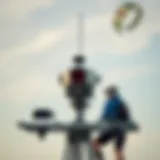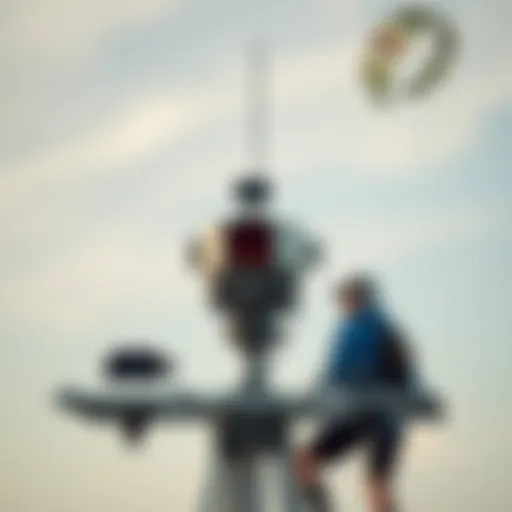Kiteboarding Adventures in the Bay Area: A Complete Guide
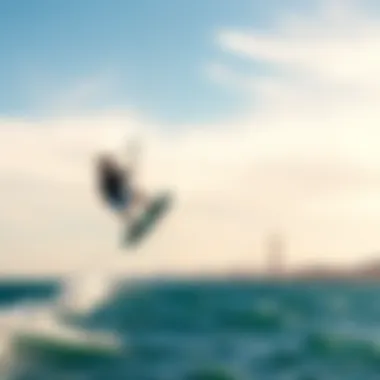
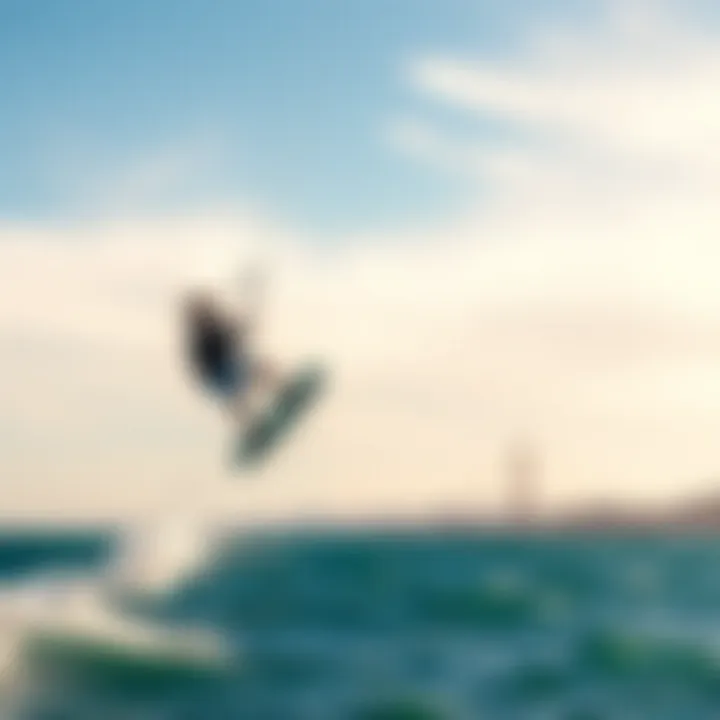
Intro
Kiteboarding in the Bay Area is not just a sport; it’s a way of life for many enthusiasts. The convergence of consistent winds, stunning backdrops, and a vibrant community makes this region a paradise for both amateur and seasoned riders. Whether you're gliding across the azure waters of the San Francisco Bay or conquering the waves at Crissy Field, the experience is exhilarating. It’s essential to recognize this unique environment filled with challenges and joys, offering various spots that suit every skill level.
To throroughly appreciate kiteboarding in this region, readers need to understand not just the essential gear and techniques but also the underlying community dynamics that elevate the entire experience. The following sections will delve into the nitty-gritty of gear options, standout locations, safety practices, and the nuances of kiteboarding techniques. As we explore these topics, kiteboarders will find themselves more prepared to ride the winds and waves, enriching their time spent on the water in the Bay Area.
Gear Insights
Gear plays a pivotal role in kiteboarding, serving as the bridge between the rider and the ocean’s currents. Whether you’re new to the sport or looking to upgrade your existing setup, understanding what makes a good kite and board can significantly enhance your outing. Below are insights regarding the latest gear and must-haves for beginners.
Latest Gear Reviews
Recent advancements in kite and board technology have transformed the experiences of riders worldwide. Popular brands like Cabrinha and Naish are on the forefront, continually refining their product lines. The Cabrinha Switchblades is well-regarded for its versatility and performance. Its easy relaunch capabilities make it a favorite among riders of all skill levels, while the Naish Pivot impresses with its high-performance characteristics during strong wind conditions.
For boards, many riders talk highly about the Liquid Force Trip, known for its stability and responsiveness. It's a solid choice for riders looking to progress in their skills. Furthermore, the rise of eco-friendly gear can't be overlooked; some companies are now producing boards made with sustainable materials, adding an ethical dimension to your surfing choices.
Essential Gear for Beginners
If you're just starting out, navigating the sea of equipment can be daunting. Here’s a checklist of gear specifically tailored for novices:
- Kite: Look for a moderate size (typically 9 to 12 meters) that’s not overly powerful.
- Harness: Comfort is key; opt for a seat harness as it provides better back support.
- Board: A larger board often provides greater stability, making it easier to get up and going.
- Safety Gear: A good impact vest or life jacket can be a lifesaver, literally.
- Wetsuit: The Bay can get chilly; a well-fitted wetsuit enhances comfort while ensuring you stay warm.
It’s always wise to test gear before committing to a purchase, especially through local shops in the Bay Area where you can get firsthand advice.
Techniques and Tips
Now that the foundation of gear is laid, it’s time to delve into the skills necessary for kiteboarding success. Mastering the basics can propel you into more sophisticated tricks and ensure that safety remains a priority.
Advanced Tricks and Techniques
Once you've got the basic skills down and are confidently cutting through the water, it’s worth exploring some advanced techniques. Tricks like the back roll and handle pass can really elevate your skillset. It often helps to watch videos of seasoned kiteboarders to understand the timing and technique involved. Local kiteboarding schools like the Kiteboarding School in San Francisco offer classes that can guide you through these tricks step-by-step.
Safety Practices for Kiteboarders
Safety cannot be overstressed. Always conduct a wind check before heading out and familiarize yourself with the local conditions. Here are a few indispensable tips:
- Check Weather Reports: Conditions can change rapidly, so stay updtaed on local forecasts.
- Stay Aware of Surroundings: Be mindful of other water users, including boats and swimmers.
- Always Wear a Harness Leash: This prevents your kite from flying away if you wipe out.
- Know Your Limits: Don’t push yourself into adverse conditions or if you’re not feeling up to it.
By focusing on gear and technique, kiteboarders can enrich their practice and embrace the spirited community found in the Bay Area. Connecting on the water doesn’t just mean tackling the waves, but also exchanging tips, sharing stories, and building friendships along the way. As we continue to explore kiteboarding in the Bay Area, we will dive into the best locations and what makes each spot unique.
Prelude to Kiteboarding
Kiteboarding, often seen as a dance between the surfer and the wind, is not merely a sport but an exhilarating lifestyle that grips the hearts of many around the globe. This article delves into the fascinating world of kiteboarding in the Bay Area, an ideal playground for both newcomers and seasoned riders. Understanding the essentials of this thrilling sport is crucial for anyone looking to harness the power of the wind and water.
Defining Kiteboarding
Kiteboarding combines elements from various water sports such as surfing, windsurfing, and paragliding. At its core, it involves riding on a board while being propelled by a large kite, which is controlled via a harness attached to the rider. To break it down, the kite captures the wind's energy, allowing riders to glide over water and even perform jumps and tricks.
For instance, imagine a vibrant rainbow kite soaring high above the Bay Area’s waters as the rider carves effortlessly through the waves. This image encapsulates the essence of kiteboarding, where skill and nature collaborate to create breathtaking displays of athleticism and artistry.
The Appeal of Kiteboarding
What draws many to kiteboarding are the unique experiences and bonding moments it creates. First and foremost, there's the unmatched thrill. Riding the crest of a wave, the wind whips around you, and you can experience what feels like total freedom. There's a sense of accomplishment that comes from mastering the sport, as novice riders swiftly become more adept.
Additionally, the social aspect cannot be overlooked. Many kiteboarders form a close-knit community with shared interests, gathering at popular spots like Crissy Field or Alameda. Here, sharing tips, tricks, and spotting each other during a jump fosters connections and camaraderie, making the entire experience richer.
Moreover, the Bay Area’s diverse landscape adds to the allure. From breathtaking views of the Golden Gate Bridge to the stunning sunsets over the water, there's a backdrop to kiteboarding that is hard to rival anywhere else.
"Kiteboarding gives you the perfect mix of thrill and peace—nothing like it!"
The Bay Area Kiteboarding Environment
When discussing kiteboarding, the surrounding environment plays a crucial role in shaping the experience. The Bay Area, with its distinctive landscape and microclimates, offers a unique playground for kiteboarders. This section delves into the essential elements of the kiteboarding environment in this region, highlighting its geographic features, wind patterns, and water conditions.
Geographic Features
The Bay Area is a real smorgasbord of geographic attributes that contribute to its kiteboarding charm. With an intricate coastline flanked by the Pacific Ocean to the west and the San Francisco Bay at its core, the variability in landscapes provides diverse environments.
From the open, expansive fields of Crissy Field to the more sheltered spots found around Alameda, each location offers a different set of challenges and thrills. The varying elevations of hills surrounding the bay create distinctive wind shadows and wind funnels, making it crucial for kiteboarders to understand the geography before hitting the water. Know where to launch and land your kite according to these geographic nuances.
Here’s a little glimpse into the main features:
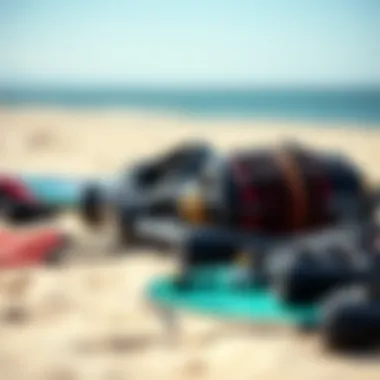
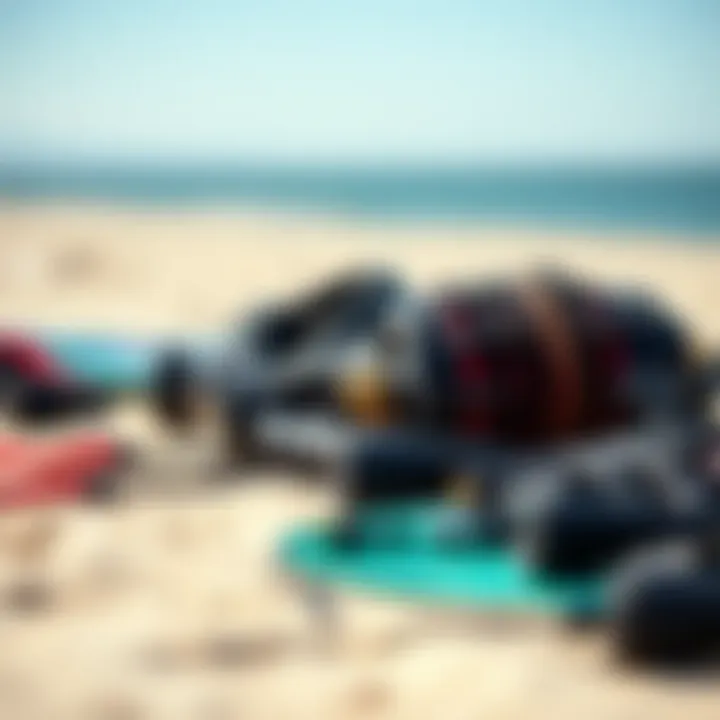
- Coastal Areas: The Pacific Ocean provides broad open waters ideal for unrestricted kite flying.
- Sheltered Spots: Areas like Alameda offer calmer conditions, suitable especially for beginners.
- Elevation Changes: Local hills significantly affect wind patterns; understanding these can make or break a kiteboarding session.
Wind Patterns and Their Significance
Wind is the lifeblood of kiteboarding; hence understanding the Bay Area's wind patterns can elevate your experience, literally and metaphorically. The region experiences marine layers that cause consistent winds, particularly during the late afternoon hours.
Kiteboarders often enjoy strong, steady winds blowing from the ocean, which is great for those seeking to push their limits. These winds can differ considerably, influenced by geographic features.
Key wind patterns include:
- Thermal Winds: Rising temperatures create thermal currents, predominantly in the afternoons, which are perfect for kiteboarding.
- Northwest Winds: Common in the summer months, these winds bring about spirited sessions at popular beaches.
- Gusts and Lulls: Be wary of unpredictable gusts that can catch unprepared kiteboarders off-guard.
Ultimately, knowing the wind nuances allows riders to plan their sessions more effectively, improving safety and fun.
Water Conditions
Water conditions also determine the kiteboarding experience significantly. The Bay Area showcases a variety of environments, from flatwater spots that foster learning to wave conditions for seasoned pros.
The tidal influences can lead to fluctuating water levels, impacting skill levels of different riders.
Considerations for water conditions include:
- Flatwater Areas: Ideal for beginners; places like the shallow parts of the San Francisco Bay are perfect for practicing.
- Wave Riding: Experienced riders often seek out areas with substantial waves, like those found at Ocean Beach, for adrenaline-pumping thrill.
- Tides: Understanding tidal flows is vital. Some locations may become shallow or receive gusty winds as tides shift.
"For anyone about to try kiteboarding in the Bay Area, pay attention to the water conditions before jumping in. It can make all the difference in your enjoyment and safety."
To sum up, the Bay Area's kiteboarding environment is multifaceted. Each aspect, from geographic features and wind patterns to water conditions, shapes the kiteboarding experience in unique ways. Understanding these elements not only enhances one’s skills but also ensures safety while on the water.
Top Kiteboarding Locations in the Bay Area
Kiteboarding enthusiasts often seek out the best locations to harness the winds and create unforgettable experiences on the water. The Bay Area serves as a playground for both seasoned riders and those new to the sport, boasting a diverse range of spots that cater to various skill levels and preferences. Understanding these top kiteboarding locations is vital; they not only present unique challenges but also offer tailored conditions that enhance the experience. This exploration delves into places that are not just popular, but where the community thrives and conditions remain favorable. Here, kiteboarders can connect with one another, share tips, and enjoy the stunning vistas that the Bay Area is known for.
Crissy Field: A Kiteboarder's Paradise
Nestled between the Golden Gate Bridge and the San Francisco Bay, Crissy Field stands out as a premier kiteboarding location. The combination of strong winds and spacious waters creates an ideal environment for riders of all abilities. The steady winds, typically ranging from 15 to 30 knots in the late spring and summer, attract kiteboarders like bees to honey.
At Crissy Field, beginners can find ample space to practice without feeling overwhelmed. There are also experienced instructors who offer lessons, turning novices into proficient riders in no time. The vibrant atmosphere is underscored by breathtaking views of the Bay, the city skyline, and the iconic bridge, making each session here a visual treat.
Location note: Always be alert for changing wind conditions, as they can turn quickly in this area.
The Challenges of Alameda
Alameda presents a mix of opportunity and challenge. While the waters here are generally flatter than those at Crissy Field, it’s the wind patterns that make this location a double-edged sword. Riders often grapple with unpredictable gusts, making it essential to have a solid understanding of local conditions. The shallow waters can also pose risks for inexperienced riders, especially during low tide.
Despite these challenges, Alameda's charm lies in its community vibe. Kiteboarders often gather, exchanging stories and tips on navigating the sometimes tricky conditions. Those who master this spot will find it rewarding, as the location offers a unique blend of technical riding and community connection.
"It's not just about the ride; it's about the people you ride with and the stories shared on the shore."
Exploring Beacon Point
Further down the coast, Beacon Point offers a somewhat quieter alternative to the hustle found at Crissy Field. This location is particularly appealing to those who relish a blend of relaxation and sport. The winds here are generally consistent, though less intense than at other locations, which makes it perfect for those looking to refine their skills without the pressure of oppressive gusts.
The scenery is nothing short of picturesque, with natural landscapes that encourage you to take a moment between sessions to appreciate your surroundings. Due to its less crowded nature, Beacon Point provides an ideal setting for kiteboarders focused on personal progression or those simply seeking a serene environment.
Pleasanton’s Hidden Gem
While Pleasanton may not be the first name that springs to mind when you think of kiteboarding, this inland site sneaks up on enthusiasts looking for something different. Unlike coastal areas, Pleasanton benefits from thermal winds that can surprise with their consistency during the summer months. This location caters predominantly to advanced kiteboarders who thrive on playing with the thermal currents.
The fact that you’re somewhat shielded from the gusts of the ocean makes it a unique experience, giving you an opportunity to experiment with new techniques and board styles. Plus, the laid-back atmosphere ensures that you won’t feel rushed, allowing for a relaxed yet focused kiteboarding session.
Engaging with these varied spots not only enhances your kiteboarding skills but also broadens your appreciation for the local kiteboarding community. Each location offers particular insights and lessons, ensuring every kiteboarding session becomes a step towards mastery.
Essential Gear for Bay Area Kiteboarding
When it comes to kiteboarding in the Bay Area, the right gear makes all the difference. Your equipment can shape your experience, safety, and performance on the water. With the unique conditions of the Bay Area — characterized by shifting winds and variable water patterns — selecting the appropriate equipment becomes paramount for both novice and experienced kiteboarders.
Kites: Types and Selection
The kite is arguably the heart of kiteboarding. It’s not just about getting any kite; it’s vital to understand the differences in design and function.
Types of Kites
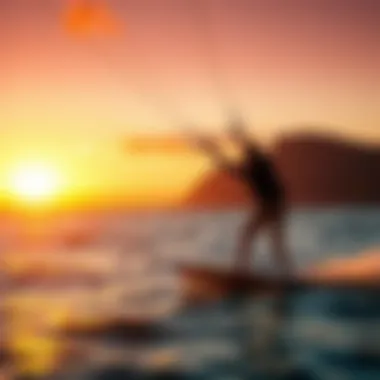

- Foil Kites – These kites are lightweight and typically deliver superior performance in lighter winds. Their aerodynamic design allows them to slice through the air with grace, making them popular for experienced riders aiming for speed.
- Ram Air Kites – Ideal for those just starting, ram air kites automatically open when pulled through the air. They provide excellent stability and are especially forgiving in tricky conditions.
- Leading Edge Inflatable (LEI) Kites – Common among Bay Area kiteboarders, LEIs are versatile and designed to endure various wind conditions. They are resilient, easy to set up, and give a significant boost in performance, especially in choppy waters.
When selecting a kite, consider your skill level, the wind conditions of your chosen location, and personal preferences like size and color. A kite’s size will typically range from 5 to 17 meters, so it’s important to match the size with the prevailing wind conditions. Remember, a larger kite catches more wind but also requires more skill to handle.
Boards: Finding the Right Fit
Choosing the right board is just as critical as selecting a kite. Boards come in various shapes, sizes, and materials, impacting your ride's speed, maneuverability, and comfort.
Characteristics of Kiteboards
- Directional Boards – Great for those who like to surf. These are designed for downwind riding and can provide a more fluid experience.
- Twin-Tip Boards – These boards are symmetrical and offer versatility, allowing riders to ride in either direction. They are ideal for beginners wanting stability while learning new tricks.
- Lightweight vs. Heavyweight Materials – Lightweight boards help achieve quicker tricks, while heavier boards often provide stability in choppy waters. When choosing a board, also think about its width; wider boards offer more buoyancy, which can be advantageous for lighter riders.
Safety Equipment
Safety should never be an afterthought in kiteboarding. With the excitement that kiteboarding brings, it’s essential to be prepared for any eventuality.
Key Safety Gear
- Harness – A good harness gives you a secure connection to the kite while distributing load evenly across your body. Research options like seat harnesses or waist harnesses to find your preferred fit.
- Safety Leash – This vital piece keeps you connected to the kite while also allowing for a quick release in emergencies.
- Impact Vest – Protecting your torso against falls is crucial. An impact vest cushions blows and provides some flotation.
- Helmet – Although not always mandatory, a helmet can protect your head from unexpected impacts, particularly when jumping.
- PFD (Personal Flotation Device) – In certain locations, a PFD is a requirement. Even if it’s not mandatory, the added buoyancy increases safety, especially in rough waters.
"Preparation is key. The right equipment can take your kiteboarding adventures from good to unforgettable.”
Understanding the essential gear for kiteboarding in the Bay Area gives you the foundation to enjoy this thrilling sport. Whether mastering your skills or simply cruising, having the right equipment tailored to local conditions enhances your overall kiteboarding experience.
Safety Considerations
Kiteboarding, while an exhilarating sport, carries its own set of risks. Understanding the safety aspects is crucial not only for your own well-being but for others on and off the water. Safety considerations revolve around a variety of factors including local regulations and personal safety practices. This section highlights the significance of these elements, making sure that each kiteboarder approaches the sport with both excitement and caution.
Understanding Local Regulations
Local regulations play an integral role in ensuring the safety of kiteboarders. The Bay Area has specific rules that govern kiteboarding, and knowing these can help you avoid fines and potential accidents. Each body of water has its unique set of rules, often influenced by environmental considerations and the presence of other water sports.
Here are a few noteworthy points related to local regulations:
- Designated Areas: Many kiteboarding spots have restricted zones, particularly near swimming areas or boat launches. Make sure to familiarize yourself with these zones to avoid dangerous interactions.
- Permits and Notifications: Some locations may require you to obtain a permit or notify local authorities before kiteboarding, especially during peak hours.
- Venues and Events: Special local events can affect kiteboarding access. It's wise to check community boards or websites for updates.
"Awareness of local regulations isn’t just about compliance; it’s about respecting the environment and the people around you."
You can find detailed information regarding local regulations on government environmental sites like *.gov or organizations focused on water activity regulation.
Personal Safety Practices
Personal safety practices comprise the day-to-day habits that kiteboarders adopt to ensure their own safety. Even if you’re confident in your skills, a strong safety protocol can drastically reduce the risk of injury.
Some essential personal safety practices include:
- Wearing a Life Jacket: Always wear a life jacket for buoyancy. Even strong swimmers can tire quickly or find themselves in unexpected situations.
- Assessing Weather Conditions: Keep an eye on the sky. Wind and weather can change rapidly in the Bay Area. If it seems sketchy, it’s better to stay on land than take unnecessary risks.
- Buddy System: Try to kiteboard with a partner. It’s not just about companionship but also having someone who can assist in case of trouble.
- Regular Gear Checks: Inspect your equipment before hitting the water. Look for frayed lines or wear and tear, as faulty gear can lead to mishaps.
Incorporating these safety practices into your kiteboarding routine lays a strong foundation for a safe experience.
Kiteboarding's thrill does not have to come with a heavy cloak of danger. By adhering to local regulations and integrating robust safety practices into your routines, you can fully embrace the adventure with peace of mind.
Training and Instruction
Kiteboarding is not just a thrilling sport; it's also an endeavor that demands a good deal of skill, understanding, and respect for nature. Proper training sets the foundation for safe and enjoyable kiteboarding experiences, making it essential for enthusiasts at all levels. The right instruction not only teaches techniques but also instills the importance of safety and local regulations. For newcomers, finding quality instruction can determine whether their early experiences will be exhilarating or frustrating.
Finding Quality Instruction
When venturing into kiteboarding, the first step is to find reputable instructors. Quality instruction can make or break your ability to ride smoothly across the water. Here are some aspects to consider when you’re searching for the right instructor:
- Certifications: Look for instructors certified by recognized organizations, like the International Kiteboarding Organization (IKO) or the Kiteboarding Association. These certifications often indicate adherence to safety standards and best practices.
- Experience: An instructor with years of teaching under their belt will likely handle various situations better than someone who is new to the profession. You might want an instructor who can share personal tips derived from their own experiences on the water.
- Customization: Every student has unique needs. Good instructors adapt their teaching style based on your skill level, learning pace, and concerns. They’ll spend time assessing your strengths and weaknesses, ensuring you are between prepared for the wind's whims.
- Safety-focused Approach: When looking for instruction, ensure that safety is a top priority. An experienced instructor will not only teach you how to control the kite but also every aspect of safety gear and emergency procedures.
"The key to learning kiteboarding is to embrace the wind and water, but never forget that safety is like an anchor—it keeps you steady when conditions get rough."
Self-Taught Techniques
While professional instruction is highly recommended, some individuals may prefer to learn kiteboarding through self-taught techniques. Here are some considerations to keep in mind if you decide to go this route:
- Video Tutorials: There’s a treasure trove of online resources. Websites like YouTube have countless videos showcasing different aspects of kiteboarding. From basic kite control to complex tricks, watching seasoned riders can give you valuable insights.
- Community Engagement: Joining local kiteboarding forums or social media groups can be incredibly beneficial. Engaging with experienced kiteboarders in the Bay Area may provide real-time advice and even local knowledge that online sources might miss.
- Learning by Doing: Kiteboarding predominantly relies on feeling the wind and water. If you have access to a safe area, practicing with friends can offer invaluable on-water experience. Make sure to bring a buddy along for safety's sake while trying new moves.
- Investing in Gear Responsibly: Since self-taught kiteboarders may be prone to trial and error, ensure that the gear you invest in suits your current skill level. Overestimating your abilities with advanced equipment can lead to frustration and accidents.
Local Kiteboarding Community
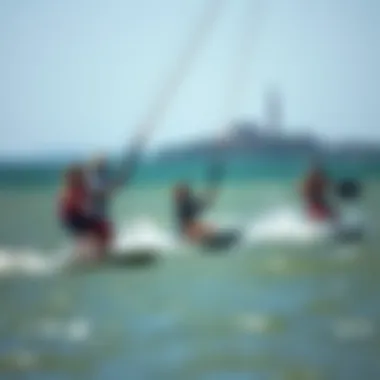
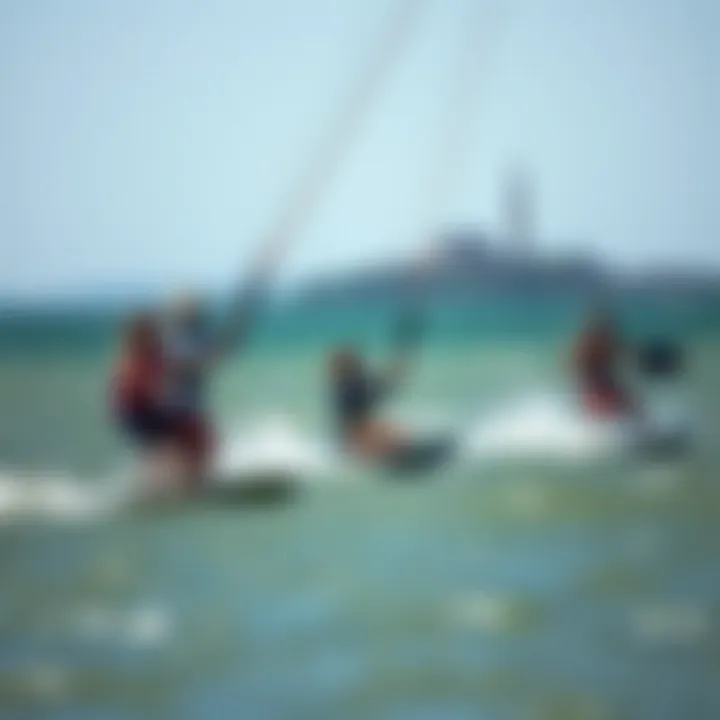
The kiteboarding community in the Bay Area is more than just a collection of enthusiasts; it’s a vibrant network that fosters connection, shared knowledge, and camaraderie. This sense of community enriches the overall experience not only for novices but also for seasoned riders. Breaking the ice can be as simple as striking up a chat with someone at the beach or joining a local club. The value in this communal bond comes from the opportunity to learn from each other, share stories, and discuss the ever-evolving kiteboarding techniques and gear.
Having a supportive network is essential, especially for those just dipping their toes into the sport. Many kiteboarders find mentorship in local clubs, where seasoned practitioners offer guidance on safety practices, best gear options, and where to find the best winds. Moreover, the community actively participates in discussions surrounding environmental concerns. Keeping the waterways clean and accessible is a priority that many clubs rally around, thus promoting sustainability within their sport.
Clubs and Organizations
The Bay Area is home to several prominent kiteboarding clubs and organizations that serve as pillars within the local scene. These groups not only host events and training sessions but also advocate for the interests of kiteboarders. Clubs like Bay Area Kiteboarding and Kiteboarding Association of California are great examples that offer various programs tailored to all skill levels.
Members of these organizations can expect:
- Regular meet-ups to share experiences and go kiteboarding together.
- Training workshops led by certified instructors who cover a wide range of skills, from basic maneuvers to advanced tricks.
- Access to exclusive events, including race days and social gatherings.
Notably, many clubs organize regular beach clean-up sessions, reinforcing their commitment not only to the sport but to protecting the natural beauty surrounding their favorite kiteboarding spots. Becoming a member can be an enriching experience, connecting individuals to resources and information that can significantly enhance their kiteboarding journey.
Events and Competitions
Events and competitions are the lifeblood of the local kiteboarding scene, serving as both a showcase of talent and a platform for learning. Various competitions are held throughout the year, from friendly local contests to larger-scale events that attract kiteboarding talent from far and wide.
These gatherings foster healthy competition while allowing kiteboarders to witness some of the best in the sport showcase their skills, often leading to an atmosphere charged with excitement. Riders can gain invaluable insights from watching their peers, sparking ideas and inspiration for improving their own techniques.
Prominent events such as the Bay Area Kiteboarding Championship or community-driven gatherings during Kiteboarding Month enable participants to engage in:
- Skill contests that test everything from speed to creative tricks.
- Workshops and clinics run by experts focusing on specific aspects of kiteboarding, such as jumping or navigation.
- Networking opportunities where kiteboarders can form connections and friendships that go beyond just riding.
Travel Considerations for Kiteboarders
When thinking about kiteboarding in the Bay Area, several elements come into play that can shape your experience. It's not just about the thrill of riding the wind; travel considerations can greatly impact your overall enjoyment and safety on the water. Understanding the best times to visit and knowing where to stay can make all the difference, especially for those who want to maximize their kiteboarding experience.
Best Times to Visit
Timing is everything when it comes to kiteboarding. The Bay Area presents some unique challenges and rewards, influenced heavily by its wind seasons. Generally, the prime time for kiteboarding enthusiasts tends to fall between late spring and early fall. The months of May through October are particularly popular, as thermal winds kick in and create consistent riding conditions.
In summer, the reliable afternoon winds can feel like clockwork, offering a refreshing boost as temperatures rise. However, be mindful that popular locations can get crowded during peak months. For kiteboarders seeking a quieter experience, a visit during the shoulder seasons—April or September—may be beneficial. The winds may not be as consistent, but the smaller crowds provide a more relaxed atmosphere.
Knowing when to come can save you hassle and leave you with an unforgettable experience.
Factors to Consider:
- Local Events: Keep an eye on local competitions or festivals, as these can draw crowds.
- Weather Patterns: Wind and water conditions can be unpredictable. It’s worth checking forecasts before heading out.
- Crowd Levels: Some kiteboarders prefer to avoid the busy weekends. If solitude is what you seek, weekdays may suit you better.
Accommodations and Accessibility
Finding the right place to stay while kiteboarding in the Bay Area is crucial. Adequate accommodations not only provide a good night’s sleep but also easy access to the beach or launch sites. The following factors come into play:
Local Lodging Options
- Hotels and Inns: Many kiteboarders prefer hotels near the waterfront, which tend to offer stunning views and easy access. Chains like Holiday Inn Express or local boutique hotels around Crissy Field can be good finds.
- Airbnb or Vacation Rentals: These options may provide a more home-like feel, which can be great for groups or families. Look for places where you can keep your gear safe.
- Camping: For the adventurous, some locations allow camping nearby. Just ensure you’re aware of local regulations like permits.
Transportation Considerations
Accessibility is key when you’re planning trips to different launching spots. Public transport can be spotty, so if you’re serious about kiteboarding, consider renting a car. This not only gives you the freedom to explore but also allows for flexibility with transporting your gear.
Accessibility Features to Look For:
- Parking: Ensure there is adequate parking near the kiteboarding spots.
- Local Shops: Check for nearby shops where you can rent or buy gear, in case of any last-minute needs.
- Launching Areas: Look for locations that provide convenient access to the water, and if possible, confirm that they have facilities like restrooms or showers.
Culmination: The Future of Kiteboarding in the Bay Area
The future of kiteboarding in the Bay Area stands at an exciting crossroads. With a rich tapestry of wind conditions, water expanses, and a steadily growing community, kiteboarding is poised for both expansion and evolution within this vibrant locale. The significance of understanding emerging trends and sustainability efforts cannot be overstated; these elements serve not just to enhance kiteboarding experiences, but to ensure the longevity of the sport itself.
Emerging Trends
As more enthusiasts flock to the sport, the kiteboarding scene in the Bay Area is beginning to flourish with new trends. One noteworthy shift is the growing attraction towards eco-friendly gear. Manufacturers are now focusing on sustainable materials for their kites and boards. More riders are opting to use products that boast better environmental credentials. For example, brands like Slingshot and Naish are incorporating recycled materials in their products, which appeals to both eco-conscious riders and new enthusiasts looking to make responsible choices.
Another pivotal trend is the integration of technology in kiteboarding. Innovations such as wearable devices that track performance metrics, such as speed and airtime, are becoming more prevalent. These gadgets not only appeal to competitive kiteboarders but also to recreational riders who want to push their boundaries. Additionally, we see more interest in the teaching of freestyle and wave riding techniques, showing that the kiteboarding community remains dynamic and diverse.
- The evolution in designs and materials for kites and boards
- Increased use of wearable tech for tracking performance
- Emphasis on freestyle and wave riding tutorials
Sustaining the Sport
To really support kiteboarding's future, it's crucial to focus on sustainability. Initiatives aimed at protecting the local marine environment play a fundamental role. The Bay Area coastline provides a unique habitat that needs our attention. Kiteboarders, as stewards of their surroundings, can help by engaging in clean-up events and advocating for policies that protect their favorite riding spots.
Moreover, the growth of the kiteboarding community leads to an influx of newcomers, which showcases the necessity for responsible riding practices. This is particularly true in crowded areas like Crissy Field, where ensuring everyone's safety and enjoyment requires mutual respect among riders. Awareness campaigns that educate both new and experienced kiteboarders about local wildlife and environmental preservation can significantly contribute to sustaining the sport.
"Sustaining kiteboarding means nurturing our waters and educating riders about their responsibility to nature, ensuring the sport thrives for generations to come."
Furthermore, local clubs and organizations can play a pivotal role in promoting sustainable practices among their members. By organizing workshops that focus on environmental awareness, local spots can enhance their reputation as both a riding haven and a model for ecological responsibility. Together, these elements underscore the essential interplay between kiteboarding’s future and conservation efforts.










